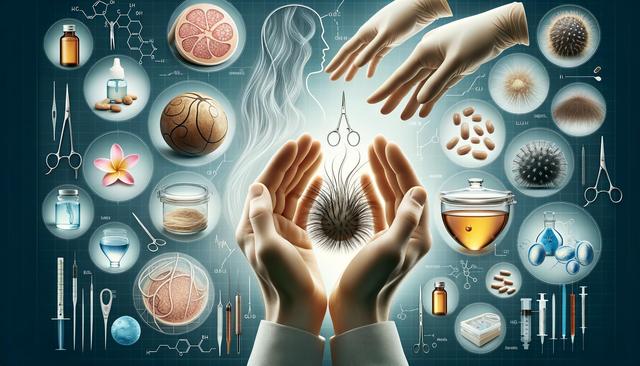Exploring Solutions for Hair Loss: What You Need to Know
Hair loss affects many individuals and exploring available solutions can help manage its impact effectively.

Understanding the Causes of Hair Loss
Before exploring solutions, it’s essential to understand why hair loss occurs. Hair loss, or alopecia, can result from a wide range of factors including genetics, hormone imbalances, stress, nutritional deficiencies, and medical conditions. In many cases, hereditary hair loss, commonly referred to as androgenetic alopecia, is the most prevalent cause. While for some individuals it may be a natural part of aging, others may experience sudden or patchy hair loss due to autoimmune disorders or adverse reactions to medications. Identifying the underlying cause is a critical first step in choosing the right treatment path.
Common causes of hair loss include:
- Genetic predisposition
- Hormonal changes such as thyroid issues or menopause
- Certain medications like those for cancer, arthritis, or depression
- High levels of stress or recent trauma
- Poor nutrition or crash diets
Consulting with a healthcare provider can help determine the specific cause and guide the decision on which treatment options might be most effective for your situation.
Topical Treatments and Medications
One of the most widely-used categories of hair loss solutions includes topical treatments and medications that stimulate hair growth or slow down hair thinning. These can be obtained either over-the-counter or through prescription, depending on the strength and purpose. Topical solutions are generally applied directly to the scalp and are designed to improve follicle health and promote new growth over time.
Common options in this category include:
- Minoxidil-based formulations
- Prescription-only medications that help block hormone-related hair loss
- Anti-inflammatory topical creams for autoimmune-related hair conditions
While many individuals find these treatments helpful, it’s important to note that results can vary. Consistency is often key, and visible improvements may take several months. Additionally, some products may come with side effects, such as scalp irritation or unwanted facial hair growth, so it’s wise to monitor your response closely and consult a healthcare professional if needed.
Non-Invasive Medical Procedures
For those seeking alternatives to daily topical applications or systemic medications, non-invasive procedures have gained attention. These treatments are often performed in clinical settings and aim to rejuvenate the scalp or stimulate dormant follicles. They offer a non-surgical approach that may suit individuals looking for a middle-ground solution.
Popular non-invasive options include:
- Low-level laser therapy (LLLT)
- Platelet-rich plasma (PRP) therapy
- Microneedling with growth factor serums
Such procedures are generally considered safe and are becoming more accessible. However, they can be costly and typically require a series of sessions to maintain results. People interested in these options should research providers thoroughly and ensure they are being treated by licensed professionals experienced in hair restoration techniques.
Surgical Hair Restoration Techniques
In cases where hair loss is more advanced or when non-surgical options have proven ineffective, surgical methods may be considered. Hair transplantation is the most well-known surgical solution and has evolved significantly in recent years. Modern techniques aim to produce natural-looking results with minimal scarring and downtime.
There are two main types of hair transplant procedures:
- Follicular Unit Transplantation (FUT)
- Follicular Unit Extraction (FUE)
Each method involves removing healthy hair follicles from one part of the scalp and transplanting them to areas with thinning or no hair. The decision between FUT and FUE depends on various factors including the extent of hair loss, donor hair availability, and personal preferences regarding recovery and scarring. While results can be long-lasting, they aren’t immediate. Full outcomes may take several months to be fully visible.
Lifestyle and Supportive Measures
While medical and surgical interventions can be effective, adopting supportive lifestyle habits can also play a significant role in managing hair loss. These measures may not reverse hair thinning on their own, but they can create an environment that supports healthy hair growth and overall well-being.
Helpful lifestyle practices include:
- Maintaining a balanced diet rich in iron, protein, and vitamins
- Reducing stress through activities like yoga, meditation, and regular exercise
- Avoiding harsh hair treatments and minimizing heat styling
- Using gentle, sulfate-free shampoos and conditioners
In addition to lifestyle changes, many individuals find value in support groups or therapy to cope with the emotional aspects of hair loss. Confidence can be significantly affected, so addressing the psychological impact is just as important as treating the physical symptoms. Consulting with a dermatologist or trichologist can help tailor a comprehensive plan that includes both clinical and supportive strategies.
Conclusion: Finding the Right Approach for You
Hair loss can be a complex and deeply personal experience, but numerous options exist to address it in a way that aligns with individual needs and preferences. From topical treatments to surgical interventions and lifestyle adjustments, exploring solutions for hair loss involves a combination of understanding the root cause and selecting the most appropriate treatment path. Consulting with professionals and setting realistic expectations are essential steps in achieving satisfying results. Whether you’re just beginning to notice thinning or seeking more advanced solutions, a tailored approach can lead to noticeable improvements in both hair health and self-confidence.